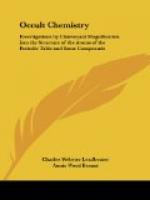[Illustration: TYPES OF HYPER-META-PROTO-ELEMENTAL MATTER.]
Here are some characteristic combinations of the Hyper state; the atom is conventional, with the depression emphasised; the lines, always entering at the depression and coming out at the apex, show the resultants of lines of force; where no line appears entering the depression, the force wells up from fourth-dimensional space; where no line appears leaving the apex, the force disappears into fourth-dimensional space; where the point of entry and departure is outside the atoms, it is indicated by a dot.[15]
The molecules show all kinds of possible combinations; the combinations spin, turn head over heels, and gyrate in endless ways. Each aggregation is surrounded with an apparent cell-wall, the circle or oval, due to the pressure on the surrounding matter caused by its whirling motion; they strike on each other[16] and rebound, dart hither and thither, for reasons we have not distinguished.
[Illustration: TYPES OF META-PROTO-ELEMENTAL MATTER.]
The Meta state, in some of its combinations, appears at first sight to repeat those of the Hyper state; the only obvious way of distinguishing to which some of the molecules of less complexity belong is to pull them out of the “cell-wall”; if they are Hyper molecules they at once fly off as separate atoms; if they are Meta molecules they break up into two or more molecules containing a smaller number of atoms. Thus one of the Meta molecules of iron, containing seven atoms, is identical in appearance with a Hyper heptad, but the latter dissociates into seven atoms, the former into two triads and a single atom. Long-continued research into the detailed play of forces and their results is necessary; we are here only able to give preliminary facts and details—are opening up the way. The following may serve as characteristic Meta types:—
These are taken from constituents of the various elements; 1 from Gl; 2 and 3 from Fe; 4 from Bo; 5, 6 and 7 from C; 8 from He; 9 from Fl; 10, 11, 12 from Li; 13 and 14 from Na. Others will be seen in the course of breaking up the elements.
The Proto state preserves many of the forms in the elements, modified by release from the pressure to which they are subjected in the chemical atom. In this state various groups are thus recognizable which are characteristic of allied metals.
[Illustration: TYPES OF PROTO-ELEMENTAL MATTER.]
These are taken from the products of the first disintegration of the chemical atom, by forcibly removing it from its hole. The groups fly apart, assuming a great variety of forms often more or less geometrical; the lines between the constituents of the groups, where indicated, no longer represent lines of force, but are intended to represent the impression of form, i.e., of the relative position and motion of the constituents, made on the mind of the observer. They are elusive, for there are no lines, but the appearance of lines is caused by the rapid motion of the costituents up and down, or along them backwards and forwards. The dots represent atoms, or groups of atoms, within the proto-elements. 1 is found in C; 2 and 3 in He; 4 in Fl; 5 in Li; 6 in N; 7 in Ru; 8 in Na; 9 and 10 in Co; 11 in Fe; 12 in Se. We shall return to these when analysing the elements, and shall meet many other proto-elemental groupings.




